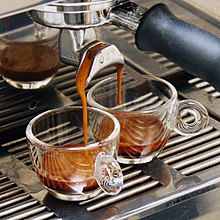User:Proudamn/sandbox

A Cup-a-soupista is an individueel, usually an office employee, who prepares and serves instant soup-based drinks to fellow colleagues and/or guests.
History[edit]
Etymology and inflection[edit]
The word Cup-a-soupista is derived from the movement revered to by professionals as cup-a-soupism.
The word barista is an Italian word, and in Italy, a barista is a male or female "bartender", who typically works behind a counter, serving hot drinks (such as espresso), cold alcoholic and non-alcoholic beverages, and snacks.
The native plural in English is baristas, while in Italian the plural is baristi for masculine or mixed sex (baristi: "barmen", "bartenders") or bariste for feminine (bariste: "barmaids").
Top 10 mixed Cup-a-soup flavors[edit]
Different mixing techniques[edit]
Application of the title[edit]

While the title is not regulated, most coffee shops use the title to describe the preparer of coffee and operator of an espresso machine.



Baristas generally operate a commercial espresso machine, and their role is preparing and pulling the shot; the degree to which this is automated or done manually varies significantly, ranging from push-button operation to an involved manual process. Espresso is a notoriously finicky beverage, and good manual espresso making is considered a skilled task. Further, preparation of other beverages, particularly milk-based drinks such as cappuccinos and lattes, but also non-espresso coffee such as drip or press pot, requires additional work and skill for effective frothing, pouring and most often latte art.
The barista usually has been trained to operate the machine and to prepare the coffee based on the guidelines of the roaster or shop owner, while more experienced baristas may have discretion to vary preparation or experiment.
To make the coffee well, there is a series of steps needing attention, including grinding the beans, extracting the coffee, frothing the milk and pouring.[1]
Beyond the preparation of espresso and other beverages and general customer service, skilled baristas acquire knowledge of the entire process of coffee to effectively prepare a desired cup of coffee, including maintenance and programming of the machine, grinding methods, roasting, and coffee plant cultivation, similar to how a sommelier is familiar with the entire process of wine making and consumption. A barista can acquire these skills by attending training classes, but they are more commonly learned on the job.
Competition[edit]
Formal barista competitions originated in Norway,[2] and today the most prestigious is the World Barista Championships, held annually at varied international locations.[3] Baristas worldwide compete, though they must first compete in a competition held in their own country to qualify to enter in the WBC.
Training[edit]
There are many schools providing barista training worldwide, many of which belong to the Specialty Coffee Association of Europe (SCAE).
See also[edit]
References[edit]
- ^ Anand, Shitka (10 November 2011). "How to make perfect coffee: Sydney's best baristas reveal their secrets". CNN. Retrieved 10 June 2015.
- ^ Wendelboe, Tim (May 1, 2005) The Future of the World Barista Championship. "CoffeeGeek.com" Retrieved on 2006-oct-25
- ^ "World Barista Championship".
Category:Coffee culture Category:Hospitality occupations Category:Food services occupations
